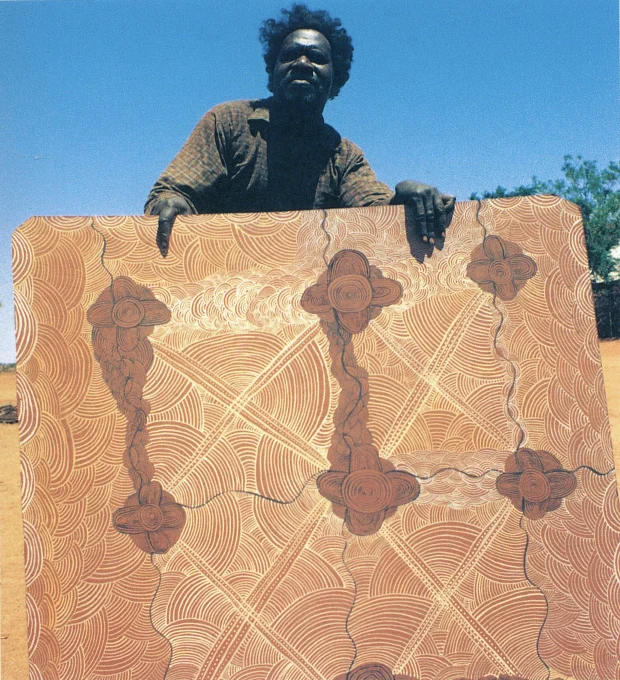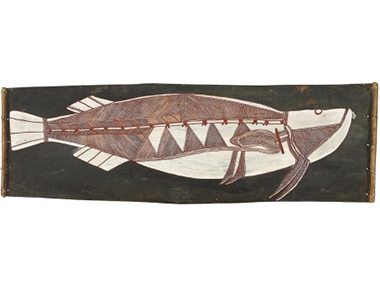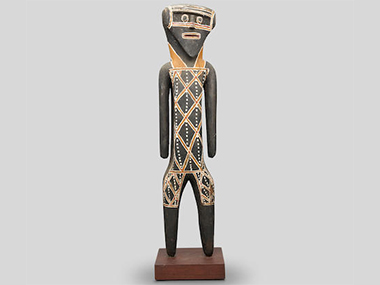Repatriated Art at Auction

Long Jack Phillipus Tjakamarra, at Papunya in 1972, with his outsize painting, 'Untitled' (Kalipinya).
Posted by Jeremy Eccles | 15.07.20
Gallery: Bonhams
Dates:
25.06.20
: 21.07.20
Coincidentally, two substantial foreign collections of Aboriginal art have been returned home in COVID-time to be sold at auction. Tonight, online, Deutscher & Hackett offer the Peter and Renate Nahum Collection from London. And on 22 July in Sydney, Bonhams put up the Serra Collection from Spain for sale.
During a seventeen-year tenure at Sotheby’s London, Peter Nahum established the Victorian Painting Department and became head of the British Painting Department until his departure in 1984 to set up his own gallery. It would become Peter Nahum At The Leicester Galleries, and over twenty-five years as a passionate art dealer and expert followed. Located in St. James, London, the gallery specialised in high-quality nineteenth and twentieth-century British art.
From the 1970s Peter Nahum produced numerous scholarly publications and from1981 to 2002 was a regular contributor to the BBC's popular 'Antiques Roadshow'. In 2017, he built the online website for the Burne-Jones Catalogue Raisonné and continues to act as adviser and coordinator to the project.
Reflecting on his career, Peter Nahum mused: “Dealers are glorified collectors … the only difference between a dealer and a traditional collector is that a dealer’s collection is, in principle, faster-moving – their motto must be Sell and Regret”.
Given this specialist history, Peter and Renate Nahum’s surprising engagement with Australian art began in the late 1980s. Assembled over a period of twenty years, the Nahum Collection of Aboriginal Art is the antithesis of Victorian English painting but reflects their enquiring minds and keen eyes. The bold simplicity of the art of The Kimberley and the fine bark designs of John Mawurndjul resonated for them as parts of a unique and truly international art movement.
Looking at Australian Aboriginal Art with fresh eyes, the collection highlights the importance of barks from Maningrida, Yirrkala and Western Arnhem Land, which stand in stark contrast to a distinctive group of Utopia paintings and the Western art imagery of urban Aboriginal artists. These extreme points in contemporary Aboriginal art history are observed from a curator’s perspective.
Meanwhile, over at Bonhams, the Serra Collection came together thanks to the adventuring spirits and passion for collecting of three key figures who serendipitously crossed paths in late 1940s Spain. Surrealist sculptor Eudald Serra (1911-2002) was an important member of Amics de l’art nouveau, a group that promoted avant-garde art in the 1930s. In 1935 he left Barcelona for Japan, living amongst traditional sculptors and potters and studied under ceramicist, Hamada Shoji. During a visit to Hokkaido in 1947, his interest in Indigenous cultures deepened and he began to create busts of its inhabitants which he called ‘plastic anthropology’. When Serra returned from Japan in 1949, he also brought with him a collection of objects.
Augusto Panyella (1921-1999), the director of the Ethnology Museum of Barcelona, had read in the newspaper about the return of the Catalan sculptor and was eager to make his acquaintance. Following their meeting, Panyella was to make the important introduction to Alberto Folch (1922-1988) which would lead to a lifelong friendship and collaboration between the three men to grow the Ethnology Museum’s collection. Incidentally, Serra’s sculptural work now adorns the façade of the Museum.
Chemist and businessman Alberto Folch inherited his love of collecting from his father, Joaquin Folch Girona, who had put together one of Spain’s largest and most important mineral collections. Alberto developed a particular interest in ethnology during his military service in the Canary Islands. From there he travelled regularly to Africa, where he collected his first pieces.
Through the 60s and 70s, Serra, Folch and Panyella undertook expeditions to some of the most remote parts of the globe, selecting and purchasing objects for the Museum. Folch took on the role of photographer to document the trips, whilst his wife Margarita and Serra were responsible for the video recordings. Their voyages included Africa, India, Nepal, Oceania and parts of Asia. Serra travelled several times to Japan to expand this part of the Museum’s holdings.
It was on two trips to Australia during that time that Serra collected the 11 bark paintings, 4 sculptures and the monumental Papunya board offered in Bonhams' sale. Folch and Serra were astounded by the topography of the continent – in particular, the spectacular site of Uluru: “A rock, rising up 350 metres and 9km of solid and incomprehensible stone in the middle of a dry plain, shaped by the wind”. As Folch described it, “as powerful as the work of an ancient architect and more impressive than the Sydney Opera house”.
The works acquired in Australia were later exhibited in Barcelona and Madrid. Serra was to become the Folch Foundation’s curator upon Folch’s passing in 1988, and in 2011 a large part of the Foundation’s collection was transferred to the Ethnology Museum of Barcelona, now part of the New Museum of World Cultures, Barcelona.
The highlight of the Eudald Serra Collection on sale is undoubtedly Long Jack Phillipus Tjakamarra’s monumental 'Untitled' (Kalipinypa), 1972. Painted at Papunya during the key 1971-72 period that marked the dawn of the Desert painting movement, this remarkable work depicts the artist’s ancestral country and birthplace, Kalipinypa, using the traditional sand painting designs associated with Water and Rain Dreamings. At 119.0 x 122.0cm, it is the largest Papunya board ever to come to market by the artist and it is the first time it has been offered for sale since its acquisition in 1972.
Serra almost certainly bought 'Untitled' (Kalipinya) from the Stuart Art Centre in Alice Springs, and probably paid little more than $100 for it. A photo of Long Jack with the painting was taken by either Serra or his travelling companion, Alberto Folch. John Kean, who was art adviser at Papunya from 1977 to 1979 and worked with Long Jack told the 'Australian Financial Review' that 'Untitled' (Kalipinya) typifies the compositional breakthroughs that occurred in the Men’s Painting Room at Papunya in the months between the departure of seminal art teacher Geoffrey Bardon in August 1972 and the arrival of the next art adviser, Peter Fannin in December. “It was a period of amazing stylistic diversity without anyone supervising,” he said. “To me it’s one of the most exciting times because people are doing all sorts of things … they are painting with intention.”
In such a vastly different continent and culture, did Serra recognise in Long Jack a fellow avant-garde artist? As one of the founding members at the ‘birth’ of the contemporary Aboriginal art movement, Long Jack certainly recognised the importance of what the Painting Men had begun: “We started it, like a bushfire this painting business, and it went every way, north, east, south and west. Papunya in the middle”.
Both of these collections are, one guesses, primarily bought with ethnographic intent – especially the Serra. So his selection of the post-ethnographic Long Jack Phillipus work is intriguing and definitely justifies expert Francesca Cavazzini's speculation about his recognition of a fellow “avant-garde artist”. While most of Serra's bark selections are pretty ho-hum, I have an affectionate feeling for Lipundja's commanding statuette of a 'Mokuy' figure. Jimmy Lipundja. who died in 1968, made quite a hit at the AGNSW's big Milingimbi show a few year's ago, revealing a tremendous variety in his interpretations of the honey story. He'd inherited associations with the Gupapuyngu Daygurrgurr estate of Djiliwirri on the Arnhem mainland, which was the location of the Yirritja honey story known as niwuda.
The Nahums also collected many a bark – from early Johnny Mawurndjul via a classic 'Barramundi' by Lofty Bardayal to several recent works by Waturr Gumana – presumably an offspring of the late Gangan master, Dr Gumana - many bought, I note, from their association with the Vivian Anderson Gallery in Melbourne. But they also ventured into canvases by Rover Thomas, Dorothy Napangardi and Trevor Nickolls, and seem to have purchased the ugliest Emily Kngwarreye I've ever seen! There's no accounting for taste in art.
But why, one wonders are they turning up at this time in Australia? Did last year's US market enthusiasm for our art inspire the repatriation? Or were they afraid the artworks would catch COVID in Europe??? If I find out from the auction house experts, I'll let you know that part of the story.
Share this:
»  del.icio.us
»
del.icio.us
»  Digg it
»
Digg it
»  reddit
»
reddit
»  Google
»
Google
»  StumbleUpon
»
StumbleUpon
»  Technorati
»
Technorati
»  Facebook
Facebook
Contact Details
Gallery: Bonhams
Email: info.au@bonhams.com
Telephone: +61 2 8412 2222
Address: 97-99 Queen Street Woollahra Sydney 2025 NSW
Gallery: Bonhams
Email: info.au@bonhams.com
Telephone: +61 2 8412 2222
Address: 97-99 Queen Street Woollahra Sydney 2025 NSW

Lofty Bardayal Nadjamerrek's 'Barramundi' (c1960) seen at D&H auction

Jimmy Lipundja's Wild Honey Figure 'Mokuy' from 1964 in Milingimbi
Where is the exhibition?
Further Research
Gallery: Bonhams
Artists: Dorothy Napangardi | Emily Kngwarreye | Gawirrin Gumana | Jimmy Lipundja | John Mawurndjul | Lofty Bardayal | Long Jack Phillipus Tjakamarra | Rover Thomas | Trevor Nickolls | Waturr Gumana
News Tags: Bonhams | Deutscher & Hackett | Eudald Serra | Jeremy Eccles | Papunya Tula | Peter Nahum
News Categories: Auction | Australia | Blog | Event | Exhibition | Feature | Industry | News
Exhibition Archive
- 15.07.20 | Repatriated Art at Auction
- 08.07.20 | Kaurna Shield Comes to Adelaide
- 02.07.20 | Yiribana
- 26.06.20 | Fashion Goes Indigenous
- 02.06.20 | RIP Malu Gurruwiwi – Custodian of the Banumbirr
- 11.05.20 | BIDYADANGA CLOSE-UP
- 07.05.20 | Boomerang Back to the Start
- 29.04.20 | Cooked???
- 24.04.20 | Mrs Ngallametta
- 23.04.20 | NATSIAA Pre-Selections Revealed
- 20.04.20 | CIAF 2020
- 10.04.20 | Marginally Good News
- 06.04.20 | ON & OFF IN ABORIGINAL ART
- 26.03.20 | Out on Country!
- 19.03.20 | BIENNALE OF SYDNEY 2020
Advertising

